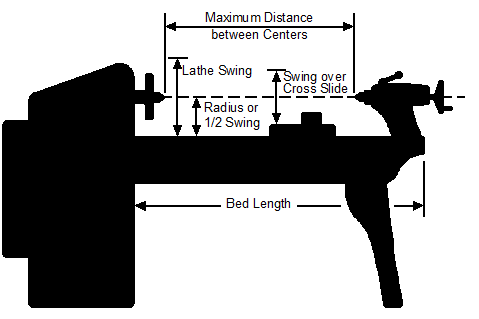- Acknowledgements
- Introduction
- Chapter 1: Measurement Tools, Layout & Job Planning
- Chapter 2: Basic Hand Tools
- Chapter 3: Filing & Sawing
- Chapter 4: Grinding, Reaming, Broaching & Lapping
- Chapter 5: Drills & Drilling Operations
- Chapter 6: Threads & Threading
- Chapter 7: Turning Operations
- Chapter 8: Milling Operations
- Chapter 9: Fastening Methods
- Chapter 10: Why Steel Hardens
- Chapter 11: Safety & Good Shop Practices
- Chapter 12: Other Shop Know-how
- Appendix I: Sharpening Steel Lathe Tools
- Appendix II: Surface Speed Table & Cutting Tool Selector Chart
- Appendix III: Decimal Equivalents of Fractional, Letter & Metric Drills
- Glossary
- Index
Chapter 7
Turning Operations
When a true genius appears in the world, you may know him by this sign,that all the dunces are against him.
—Jonathan Swift
Introduction
The lathe is the oldest and most basic machine tool. Egyptians used primitive lathes at least 3000 years ago. Lathes work by holding and rotating a workpiece while a tool, whose position is controlled by the lathe, is held against the work. Lathes can cut cylinders and cones, both solid and hollow. Metal lathes can make truly round parts to tolerances of less than one-thousandth of an inch that permits the production of matched components such as axles and bearings, pistons and cylinders, and gun barrels and projectiles. Lathes are also important because of their ability to thread shafts, nuts, and bolts. In addition, the lathe can turn a steel forging or cylinder into a one-piece crankshaft.
Not only does the lathe make parts required to build all other types of machine tools, it also makes components for engines, pumps, valves, vehicles, and electric motors and performs over a dozen different operations, more than any other machine tool. Because the versatile lathe makes essential parts for many of the devices that make modern life possible, you can see why 20% of all machine tools in the U.S. are lathes.
During their early development, lathes were used by furniture makers, wheelwrights, joiners, bell founders, and pulley makers. The lathe has no single inventor, but evolved as dozens of incremental improvements were added over time. Before 1700, long periods passed when the lathe saw few improvements and was limited to turning work between centers. Over the next 200 years, the lathe evolved into its present form. The basic design of lathes built after 1900 differs little from those made today. The majority of improvements were made first in England and then in the United States. Six major developments brought us to the modern lathe:
Introduction of the fixed tool holder to replace the use of hand-held tools (as in a wood lathe) was essential to making accurate cuts.
- Transition from human power to water wheels, steam, and electricity increased the size of the lathe, the work possible, and the cutting speeds.
- Replacement of wooden lathe frames with cast iron ones increased rigidity, accuracy, and cut depth.
- Development of the leadscrew for thread cutting and power feeds.
- Addition of chucks and collets extended lathe use from merely turning between centers to facing, drilling, reaming, filing, and a host of other capabilities.
- Replacement of carbon steel tool bits with high-speed steel alloys and later replacing the high-speed steel with tungsten carbide cutting tools dramatically increased cutting speeds and tool life.
While the manual lathe remains important today in making prototypes, one-of-a-kind units like huge turbine and generator shafts, and spare parts, the advent of CNC lathes and machining centers has rendered the manual lathe uneconomical for most production. However, when just a few similar parts need to be made, a skilled machinist can produce the required parts before the program for a CNC machine can be written. But on large production runs, even in low-wage, third-world countries, a modern CNC machine is often more cost-effective than a manual lathe. For this reason few factories exist today with row upon row of manual production lathes as seen in WWII films.
Some older lathe models and their components appear in this chapter because many machinists are likely to own or have to work on one. Many excellent older machines remain in shops and labs today. Most do not differ significantly from new machines. There are four reasons so many of these older machine exist:
- Unless deliberately damaged or left to rust, lathes can have working lives of over 60 years. When properly lubricated, they wear little even in heavy service. The exception is when they are cutting cast iron and not carefully and frequently cleaned of chips which are very abrasive.
- Even in worn lathes, spindle bearings can be replaced and ways can be reground at a much lower cost than buying a new lathe; also, spare parts are available for most US-made lathes built during the last 50 years.
- The economics of CNC tools displaced many lathes from production use making them surplus.
- Many jobs can be accomplished on lathes with considerable wear.
While metal lathes are the most common, other specialized lathe designs also contribute to our modern world. Some grind and polish lenses, others carve out gunstocks or shoe lasts, or cut decorative patterns in wood, metal, and plastic. Still others spin flat sheets of silver and brass into plates and pitchers, or recondition automotive brake drums. Very specialized lathe designs, called automatic screw machines, begin with rod stock and make nuts, screws, and other cylindrical metal parts at high speed and low cost.
This chapter:
- Shows how lathe work capacity is measured.
- Pictures and describes five different modern lathes that illustrate the classes of lathes you are most likely to use.
- Examines how lathes are constructed, looks at each part, and describes its function.
- Describes and compares lathe cutting tool materials, holders, and shapes.
- Investigates cutting tool feed rates and spindle speed, called “feeds and speeds,” to determine their optimum settings.
- Looks at lathe accessories, the various devices that attach to the lathe to hold the work or guide the tool and add versatility.
- Presents step-by-step procedures for setting up a lathe and then performing specific operations.
- Reviews lathe-related safety issues.
Section I – Lathe Sizes
Specifying Lathe Size
How is lathe capacity measured?
Several dimensions are needed to get a complete picture of a machine’s capacity:
- Swing over the bed is the largest diameter work that will clear the ways. Note: European manufacturers designate lathe size by the distance from the lathe center to the ways, the radius, or half the dimension we call swing over the lathe bed.
- Swing over the cross slide indicates the largest diameter work that can be turned between centers. This dimension is always less than the swing over the bed.
- Maximum distance between centers indicates the maximum length of work that can be turned. This figure takes into account the distance of the lathe bed taken up by the tailstock.
- Bed length is often mentioned, but is much less useful in comparing work length capacity of two lathes than the maximum distance between centers. This is because some beds extend under and support the headstock. This portion of the bed length is not usable compared with the same bed length in front of the spindle nose. This dimension can be misleading.
See Figure 7–1.

Figure 7–1. Lathe size measurements.
Is horsepower important when evaluating a lathe for an application?
Yes, horsepower limits the maximum depth of cut and thus maximum metal removal rate. The maximum usable lathe horsepower and metal removal rate is also limited by the:
- Strength of its power train—belts, pulleys, and gears.
- Rigidity or stiffness of the machine. Cutting operations place large forces on the carriage and lathe bed, twisting them out of alignment, degrading accuracy, and causing vibration or chattering between the work and cutting tool.
- Lathe cutting tool material, cutter size, shape, and tool mounting fixture rigidity also determine how much of the available horsepower can be used. A high-speed steel lathe bit would burn up quickly when subjected to the heat generated by the production surface speeds and feed rates a modern carbide tool easily withstands. Metal volume removal rates are 2 to 6 times higher for carbide tools than for HSS ones.
Studies show that during the last century improvements in lathe design, work holding methods and, most importantly, tool bit materials have led to 100:1 reductions in the time needed to do the same turning task on a low-carbon steel workpiece.
What other factors are important in selecting a lathe?
- Although two lathes may have the same dimensions, the one with the more robust headstock, tailstock, and carriage castings will be able to take bigger cuts, remove more pounds of metal per hour, and perform more work in a given time while maintaining accuracy. A rough way to compare lathes is by their capacity to remove metal in pounds/hour. In general, the more a lathe weighs, the stiffer its castings. This would not be as important in a work situation where the machine is only used occasionally such as in a research lab, but would be critical in a production setting.
- While the same lathe design may be calibrated in either inches or millimeters, and holds the same accuracy in either measurement unit, the lathe using the measurement units most often used in the shop is the better choice. The carriage, cross-feed and tailstock collars are usually calibrated in one or the other units, not both. Working on a machine calibrated in one set of units while using drawings dimensioned in another is possible, but it is difficult and leads to errors. Regardless of their measurement units, most lathes can cut both inch or metric threads simply by changing gears.
Modern Lathes
What are some examples of typical modern lathes?
Here are five quality lathes from very small to large:
- Levin Precision Instrument Lathe, Figure 7–2, makes parts for electrical and scientific instruments, medical devices, and watches, so Levin lathe operators frequently work under stereo-microscopes. Work made on these lathes is usually small enough to fit under a dime, and is machined in collets, but 3- and 4-jaw chucks are also used. Their standard ⅓-horsepower motors have 0–5000 rpm scr drives with IR-drop compensation to improve speed regulation. Levin offers a wide range of collets, chucks, tool holders, turret tailstocks, milling attachments, grinding attachments and coolant systems, so their lathes can be used as a tool makers’ lathe, turret lathe, or micro-drilling machine. These are very fine lathes for miniature critical and demanding applications and probably the best in its size class. A Levin lathe with a bench, cross slide, DRO (Digital Read Out), and a good selection of accessories could easily exceed $20,000. The Levin website is www.levinlathe.com.

